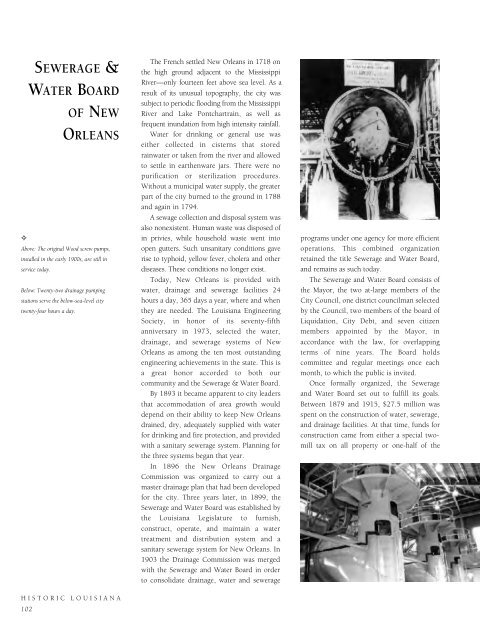Historic Louisiana
An illustrated history of Louisiana, paired with the histories of companies, families and organizations that make the state great.
An illustrated history of Louisiana, paired with the histories of companies, families and organizations that make the state great.
You also want an ePaper? Increase the reach of your titles
YUMPU automatically turns print PDFs into web optimized ePapers that Google loves.
SEWERAGE &<br />
WATER BOARD<br />
OF NEW<br />
ORLEANS<br />
✧<br />
Above: The original Wood screw pumps,<br />
installed in the early 1900s, are still in<br />
service today.<br />
Below: Twenty-two drainage pumping<br />
stations serve the below-sea-level city<br />
twenty-four hours a day.<br />
HISTORIC LOUISIANA<br />
102<br />
The French settled New Orleans in 1718 on<br />
the high ground adjacent to the Mississippi<br />
River—only fourteen feet above sea level. As a<br />
result of its unusual topography, the city was<br />
subject to periodic flooding from the Mississippi<br />
River and Lake Pontchartrain, as well as<br />
frequent inundation from high intensity rainfall.<br />
Water for drinking or general use was<br />
either collected in cisterns that stored<br />
rainwater or taken from the river and allowed<br />
to settle in earthenware jars. There were no<br />
purification or sterilization procedures.<br />
Without a municipal water supply, the greater<br />
part of the city burned to the ground in 1788<br />
and again in 1794.<br />
A sewage collection and disposal system was<br />
also nonexistent. Human waste was disposed of<br />
in privies, while household waste went into<br />
open gutters. Such unsanitary conditions gave<br />
rise to typhoid, yellow fever, cholera and other<br />
diseases. These conditions no longer exist.<br />
Today, New Orleans is provided with<br />
water, drainage and sewerage facilities 24<br />
hours a day, 365 days a year, where and when<br />
they are needed. The <strong>Louisiana</strong> Engineering<br />
Society, in honor of its seventy-fifth<br />
anniversary in 1973, selected the water,<br />
drainage, and sewerage systems of New<br />
Orleans as among the ten most outstanding<br />
engineering achievements in the state. This is<br />
a great honor accorded to both our<br />
community and the Sewerage & Water Board.<br />
By 1893 it became apparent to city leaders<br />
that accommodation of area growth would<br />
depend on their ability to keep New Orleans<br />
drained, dry, adequately supplied with water<br />
for drinking and fire protection, and provided<br />
with a sanitary sewerage system. Planning for<br />
the three systems began that year.<br />
In 1896 the New Orleans Drainage<br />
Commission was organized to carry out a<br />
master drainage plan that had been developed<br />
for the city. Three years later, in 1899, the<br />
Sewerage and Water Board was established by<br />
the <strong>Louisiana</strong> Legislature to furnish,<br />
construct, operate, and maintain a water<br />
treatment and distribution system and a<br />
sanitary sewerage system for New Orleans. In<br />
1903 the Drainage Commission was merged<br />
with the Sewerage and Water Board in order<br />
to consolidate drainage, water and sewerage<br />
programs under one agency for more efficient<br />
operations. This combined organization<br />
retained the title Sewerage and Water Board,<br />
and remains as such today.<br />
The Sewerage and Water Board consists of<br />
the Mayor, the two at-large members of the<br />
City Council, one district councilman selected<br />
by the Council, two members of the board of<br />
Liquidation, City Debt, and seven citizen<br />
members appointed by the Mayor, in<br />
accordance with the law, for overlapping<br />
terms of nine years. The Board holds<br />
committee and regular meetings once each<br />
month, to which the public is invited.<br />
Once formally organized, the Sewerage<br />
and Water Board set out to fulfill its goals.<br />
Between 1879 and 1915, $27.5 million was<br />
spent on the construction of water, sewerage,<br />
and drainage facilities. At that time, funds for<br />
construction came from either a special twomill<br />
tax on all property or one-half of the
















